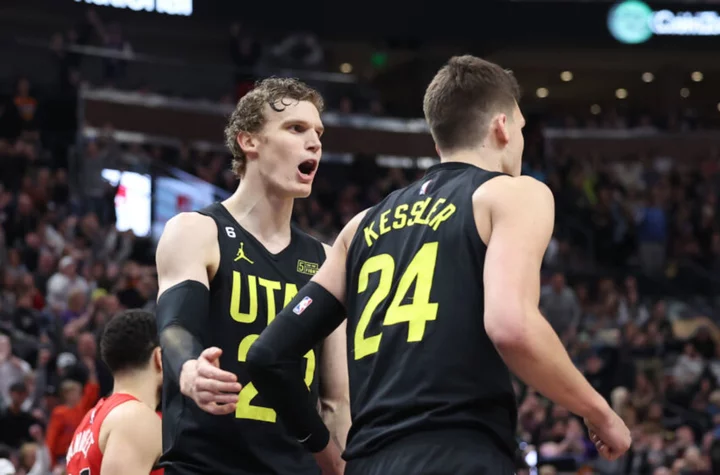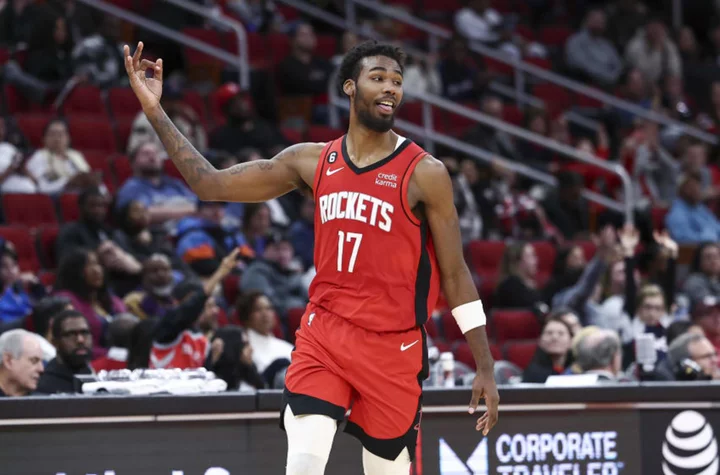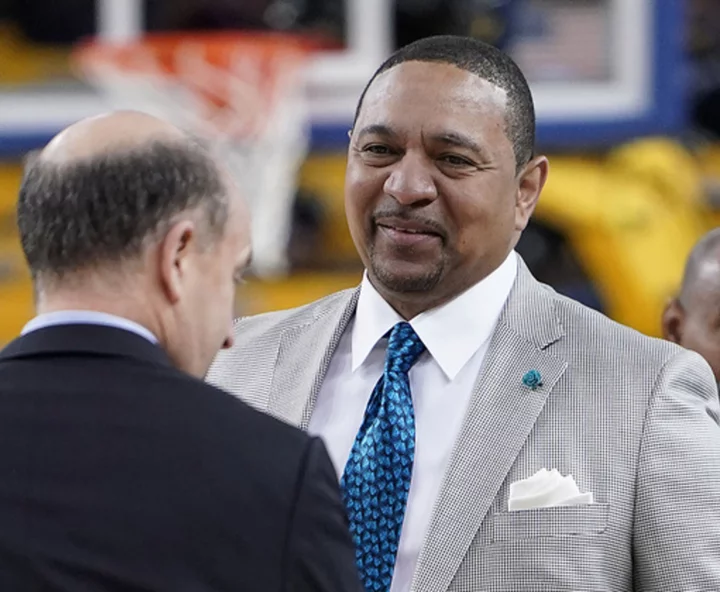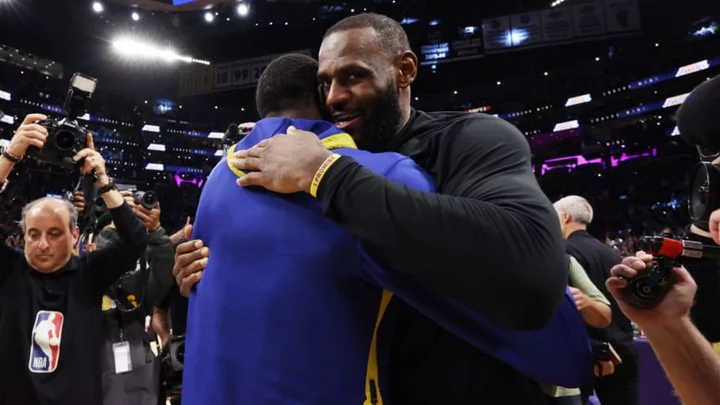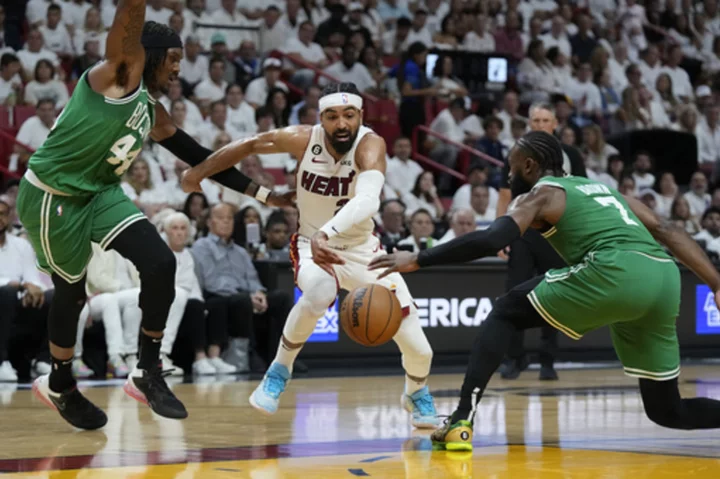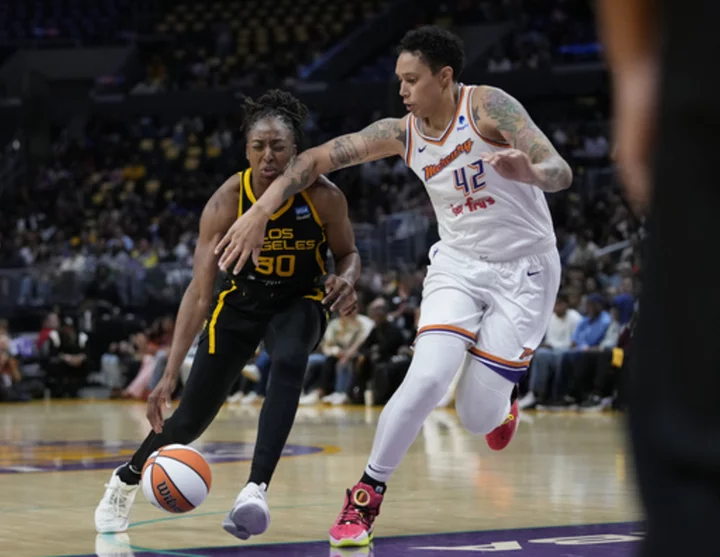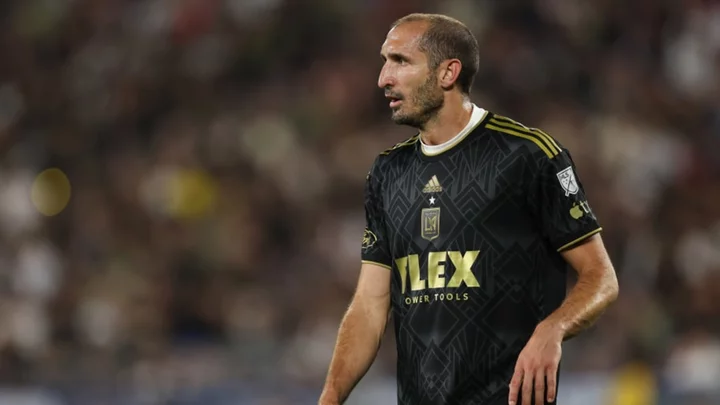The Utah Jazz were one of the NBA's most potent offensive teams last season before the tank began in earnest. With new weapons at his disposal, Will Hardy could build a contender sooner than fans expect.
The Utah Jazz began last season red-hot, shooting to the top of the Western Conference and looking — for a brief moment in time — like surprise contenders in a league with more parody than we've seen in years. Reality ultimately set in, and Utah very purposefully tanked at the trade deadline, but the Jazz are not as far from contention as fans expected after the Donovan Mitchell and Rudy Gobert trades.
Lauri Markkanen deserves the bulk of the credit for Utah's above-average standing. He went from a fourth or fifth option in Cleveland to an All-Star in his first season with the Jazz, blowing expectations out of the water as one of the most efficient isolation scorers in the NBA. Markkanen is the rare 7-footer who can defend the perimeter, score at all three levels, and reliably generate positive outcomes off the dribble.
For Utah, however, last season's peaks were the result of a total team effort. Will Hardy impressed in his first year as head coach, installing a culture of ball movement and selflessness across the board. Jordan Clarkson had his best playmaking season to date. Walker Kessler chipped in with the best defensive rookie season in recent memory. The Jazz were formidable on both ends.
Were it not for the purposefully orchestrated trade deadline nosedive, the Jazz would have contended for a play-in spot. The team almost did, despite shelling out half the roster for Russell Westbrook and spare parts. Danny Ainge and the front office correctly played the long game, but Utah is prepared to make a run sooner than later. Their moves this offseason confirmed that.
As the new season dawns, here's what Will Hardy is working with rotationally.
Utah Jazz starting point guard: Jordan Clarkson
Last season was far and away the best of Jordan Clarkson's career, and he was handsomely rewarded with a new four-year, $51 million contract over the summer. The 31-year-old survived Utah's youth pivot at the deadline and re-upped in the offseason, establishing him as a core piece for the next half-decade — a veteran to serve as a bridge from the present to the future.
Clarkson has always possessed a talent for putting the ball in the basket, but he didn't always have the most efficient approach. Last season was the best of both worlds: Clarkson supplied the Jazz with much needed self-creation on the perimeter, but he also embraced his role as a connective passer and off-ball mover. He effortlessly adjusted his approach to match different personnel groups. At times, he was one of three guards on the floor for Utah. Other times, he was running the show.
The Mike Conley trade left Utah without a traditional point guard, a problem the team didn't remedy in free agency. There are other ball-handlers on the roster Hardy will consider starting next to Clarkson, but to balance the lineup both ways, it's unwise to start Clarkson next to another undersized guard who doesn't defend (think Collin Sexton, who split time between the first and second units last season).
Clarkson doesn't offer much resistance at the point of attack on defense but he supplies decent positional size and enough of a playmaking presence to initiate Hardy's movement-heavy offense. Markkanen and others will spend plenty of time with the ball in hand, allowing Clarkson to roam, cut, and spot-up from deep. He will share the floor with others guards inevitably, even if it's not with the starting five.
Primary backup point guard: Collin Sexton
Collin Sexton was productive in his first season with the Jazz, averaging 14.3 points on .506/.393/.819 splits in 23.9 minutes per game. He started 15 of 48 appearances and saw his playing time reach a career low. He's at risk of losing more minutes this season as the Jazz incorporate No. 16 pick Keyonte George. But, despite a roster stacked against him and more injury hurdles, Sexton's return from a torn meniscus went about as well as it could have.
The concern with Sexton's long term outlook is his approach. He's undeniably talented. Not many 6-foot-1 guards can match Sexton's scoring efficiency at all three levels. He's a bursty driver with excellent craft around the rim, unafraid to absorb contact with his muscular frame. The 3-point shot remains top shelf. That said, Sexton isn't always the most willing passer and despite his well-documented intensity, he remains a poor defender. That's what will keep Sexton's minutes at bay in Utah, especially if the Jazz opt to bring him off the bench in favor of a bigger backcourt.
Other players who could receive minutes at point guard: Talen Horton-Tucker, Keyonte George, Kris Dunn
Kris Dunn arrived late last season to fill gaps in an injury-riddled rotation. The results were shockingly positive for the former top-five pick. He averaged 13.2 points and 5.6 assists on 60.6 TS% in 25.8 minutes per game. It was a small sample size — only 22 games — but more than enough to earn Dunn a more extensive look with healthy teammates next season.
Long known for his defense, the lack of a 3-point shot and consistent scoring arsenal is what had Dunn on the verge of obsolescence before his late-season resurgence with Utah. He shot 47.2 percent on 1.6 attempts per game from 3-point range with the Jazz. The sample size factors into takeaways here, but even a remotely functional jumper changes Dunn's outlook in a big way.
Utah Jazz starting shooting guard: Ochai Agbaji
Utah has several options next to Clarkson in the backcourt, but Ochai Agbaji gets the tentative nod in these projections. The second-year guard out of Kansas was initially drafted by Cleveland before joining Utah as part of the Mitchell trade. It took him a while to find his role, but Utah's tank job after the All-Star break paved the way for Agbaji to make a consistent impact.
The stats aren't anything to write home about: Agbaji played 59 games (22 starts) and averaged 7.9 points and 2.1 rebounds on .427/.355/.812 splits in 20.5 minutes. What gets him the nod over Sexton or Talen Horton-Tucker, both of whom produced superior raw numbers, is twofold: A, he's due for a second-year leap and B, he's the best defensive option.
At 6-foot-5, Agbaji is built strong with the ability to guard a couple positions. The Jazz run the risk of rostering too few quality wing defenders. If Sexton and Clarkson share the backcourt, then either Lauri Markkanen or John Collins would have to defend the elite wings of the world. That won't really cut it.
Agbaji profiles as the 3-and-D wing Utah needs in this spot. He started 19 games between May and April, so there's reason to believe his late-season role increase could carry over into the new season. He doesn't provide much pop scoring on the ball, but Agbaji actively cuts and moves off the ball, relocating for 3s or diving to the rim for simple finishes. That makes him a useful cog in Hardy's pass-happy offense.
Primary backup shooting guard: Keyonte George
We will see how long the Jazz can keep Keyonte George on the bench. He profiled as a lottery talent before the draft and was particularly impressive in Summer League. That's only Summer League, but the Jazz could benefit from George's creation ability on the perimeter — not to mention his reputation as a plus defender.
Only 6-foot-4, George will battle natural limitations on the defensive end. Still, he competes hard at the point of attack. On the offensive end, he's a genuine three-level creator, complete with dynamic handles, a talent for shifting gears, and feather-soft touch on his jumper. George embraces contact on drives to the cup and he's a master of the floater. His pull-up and step-back 3s rip cleanly through the net. There are concerns about shot selection and decision-making, but George made a point to create for teammates in Vegas. He did so effectively. He probably won't begin the season as a starter, but don't be shocked if he finishes the season next to Clarkson in the backcourt.
Other players who could receive minutes at shooting guard: Talen Horton-Tucker, Jordan Clarkson, Brice Sensabaugh
Brice Sensabaugh merits watching. The No. 28 pick out of Ohio State, Sensabaugh's pre-draft stock plummeted due to injury concerns. He was one of the most productive individual scorers in recent NCAA freshman history. There are concerns about his defense at the NBA level and he doesn't create for others very much, but Sensabaugh is a bulky 6-foot-6 with one of the prettiest jumpers you'll see. He can hit contested jumpers all day. If he progresses in other areas, it will be hard to keep him out of the lineup.
Utah Jazz starting small forward: Lauri Markkanen
The Jazz found their franchise cornerstone sooner than expected in Lauri Markkanen. He was legitimately one of the most efficient and effective isolation scorers in the NBA last season, an outcome few could have predicted after his successful but mostly vanilla stretch in Cleveland. It all started with a torrid summer with the Finnish national team, and Markkanen carried that momentum into the regular season.
Still 26 years old, the former No. 7 pick has his entire prime in front of him. Markkanen averaged 25.6 points and 8.6 rebounds on .499/.391/.875 splits, complementing his long-revered 3-point shot with remarkable success as a driver and pull-up artist in the mid-range. Markkanen is a legitimate 7-footer, capable of navigating tight spaces off the dribble and picking apart defenders with precise, balletic footwork.
While not a wing stopper by any means, Markkanen can hang on the perimeter defensively. He spent his Cleveland tenure in three-big lineups next to Jarrett Allen and Evan Mobley and will do the same in Utah next season following the John Collins trade. The Jazz will look to overwhelm opponents with length on defense while still packing a potent punch on offense.
Markkanen still has room to grow as a playmaker for others — he averaged the same number of assists (1.9) as turnovers — but the list of superior individual scorers is frighteningly small. If the Jazz can surround him with the right accompaniment of table-setters, spacers, and defenders, Utah can very quickly climb the NBA team ranks.
Primary backup small forward: Talen Horton-Tucker
Talen Horton-Tucker was essentially the Jazz's starting point guard in the final month of the season. With their guard depth ravaged by injury, Utah leaned heavily on THT's unique brand of slashing. Listed at 6-foot-4 and 234 pounds, Horton-Tucker certainly popped: he averaged 10.4 points and 3.8 assists in 20.2 minutes on 50.8 TS% for the season. He's not much of a defender and the inefficiency is a major red flag, but Horton-Tucker can get hot and find ways to put the ball in the bucket. He's going to get minutes.
The reason for his placement at small forward here is simple: Utah has several guards, all of whom will demand playing time. THT is short, but he's also strong. He doesn't have the lateral quickness to defend twitchy guards, making him more of a wing/forward for defensive purposes (his 7-foot-1 wingspan doesn't hurt).
Other players who could receive minutes at small forward: Taylor Hendricks, Brice Sensabaugh, Simone Fontecchio
Utah Jazz starting power forward: John Collins
The Hawks shipped John Collins to Utah for pennies on the dollar, ending his turbulent and unfulfilling stint with the Hawks. Collins' reputation has been on the downturn for a while but last season it bottomed out. His numbers caved across the board: he averaged 13.1 points and 6.5 rebounds on career-low .508/.292/.803 splits. On a per-minute basis, his worst offensive season since he was a rookie, and even then his percentages were much better in year one.
So, why should Utah have any optimism? Because John Collins is good. Some might say, very good. He was not well-deployed in Atlanta last season, with the Hawks almost deliberately straying away from Collins' offensive strengths. The Jazz don't have a pick-and-roll creator of Trae Young's caliber, but Utah should lean heavily into Collins' vertical presence at the rim.
On the perimeter, Collins provides more dynamism than one might expect. He's a good enough shooter to draw out the defense. Once he does, he can attack the rim with long strides and nimble footwork. He has progressed into a fairly reliable pull-up shooter in the mid-range and he's a tremendous cutter. Utah's offense thrives off movement and Collins is going to frequently make himself available at the basket, where he possesses one of the widest catch radiuses in the NBA. He's a true one-percent vertical athlete.
The cherry on top is Collins' rebounding. His numbers tanked with his minutes last season, but Collins is a committed rebounder. He vacuums up second-chance points on the offensive glass and frequently ends possessions on the defensive glass. Paired with Kessler and Markkanen in the frontcourt, Collins will make Utah one of the most formidable rebounding teams in the NBA. That's without mentioning the inherent value of his 6-foot-11 wingspan in Utah's frontcourt defense.
Primary backup power forward: Taylor Hendricks
The Jazz turned heads with the decision to select UCF's Taylor Hendricks with the No. 9 overall pick in June's NBA Draft. It wasn't surprising that Hendricks went so high, only that he went to Utah. The Jazz aren't exactly short on frontcourt depth — especially not with the Collins trade — and many thought the resources would be better spent on the backcourt.
Of course, Utah addressed those concerns with the George and Sensabaugh picks later in the first round. Hendricks will face an uphill battle for minutes given the breadth of talent in the Utah frontcourt, but the 19-year-old projects as an instant-impact contributor. At 6-foot-9, Hendricks fits the 3-and-D archetype the modern NBA covets.
Hendricks doesn't offer much as a self-creator, but he checks most other boxes. He's one of the best shooters in the draft, which isn't common at his size. He's also a bouncy interior finisher who cleans up the offensive glass on a regular basis. On defense, Hendricks might be one of the few genuine five-position defenders. He can switch on the perimeter and hang with guards, or hover around the paint and protect the rim. If he ever shares the frontcourt with Walker Kessler (he will), opposing offenses will not find much airspace when driving the lane.
Other players who could receive minutes at power forward: Lauri Markkanen, Kelly Olynyk
Utah Jazz starting center: Walker Kessler
Walker Kessler began last season on the bench, but the No. 22 overall pick from the 2022 NBA Draft swiftly established himself as the center of the future in Utah. He was part of the Gobert trade and, fittingly enough, he put together the kind of defensive profile NBA fans tend to associate with Gobert. Rookie centers often require a long runway to learn the nuances of NBA defense. Not Kessler. He was elite — and not elite for a rookie. Elite, period.
The Auburn product averaged 9.2 points, 8.4 rebounds, and 2.3 blocks in 23.0 minutes per game. His 173 blocks were the most by a rookie since Tim Duncan, and he didn't even start until midway through the season. Kessler also led the NBA in field goal percentage (72.0), doing his best Gobert impression as a towering finisher in the paint.
Kessler isn't without severe limitations — he doesn't score outside the paint, he doesn't provide much upside as a passer, he exclusively operates in drop coverage — but Utah already has one of the five or so best defensive anchors in the sport. And that's not hyperbole. Kessler finished third in Rookie of the Year voting and, while many members of his draft cohort possess higher offensive ceilings, it's hard to imagine Kessler's floor not guaranteeing himself a top-five spot in all future re-drafts. He is going to be the foundation of a top-notch regular season defense for the next decade, he's an elite rebounder, and he does his job at the highest level offensively, even if it's an extremely streamlined job.
Offense made the Jazz stand out last season, but Kessler and the defense could be what launch Utah back into the contenders circle in the near future. With Collins and Markkanen flanking Kessler, the Jazz are going to overwhelm offenses with their length and activity on the interior. The perimeter defense is a little shallow, but Kessler can clean up messes with the best of them. As Keyonte George and Taylor Hendricks mature over the years, Utah's defense should get better on the perimeter.
Primary backup center: Kelly Olynyk
Kelly Olynyk would start for a number of teams. He can split time between center and power forward, quick enough to keep up defensively but truly valuable for his offense. Olynyk is a knockdown shooter (39.4 percent on 3.5 attempts from 3-point range) with impressive finesse on finishes around the rim. He's great at punishing errant closeouts with drives to the cup and he's a well above-average passer for his position.
We have seen Olynyk approach star-level numbers when given a big enough workload. He's probably best suited to a smaller role, but the Jazz are approaching an embarrassment of riches in the frontcourt. Collins will spend time at center too, Markkanen is a 7-footer, and Hendricks was a top-10 pick for good reason. Olynyk could find himself squeezed for minutes through no fault of his own.
Other players who could receive minutes at center: John Collins

